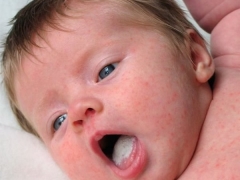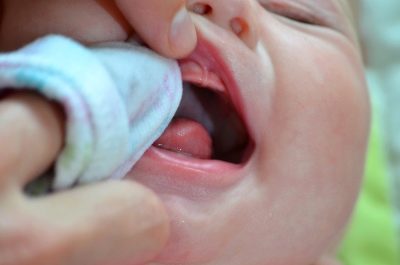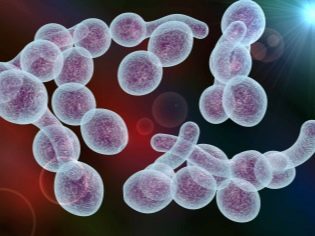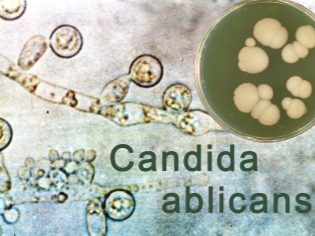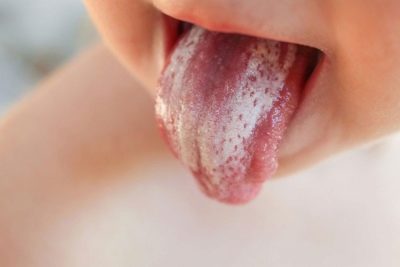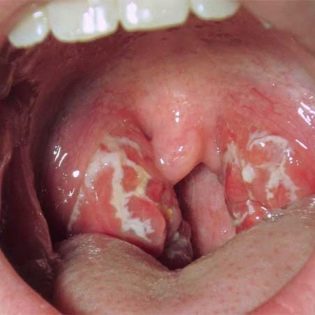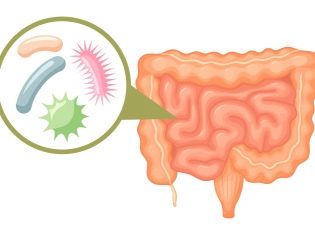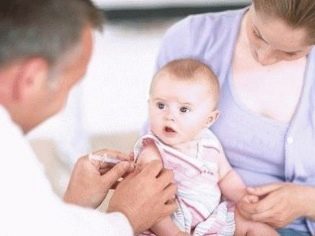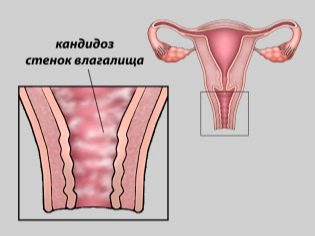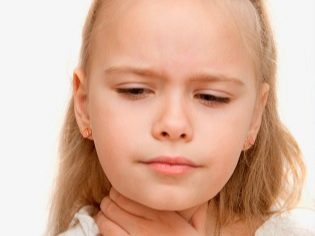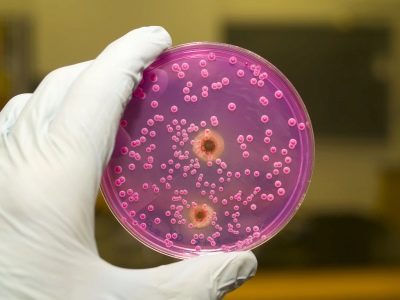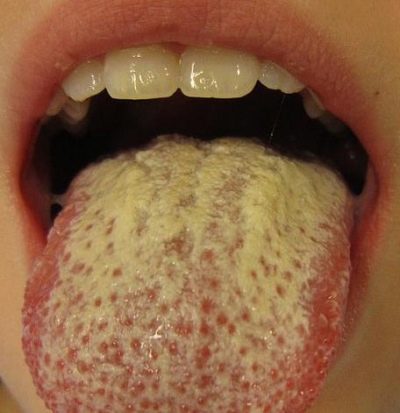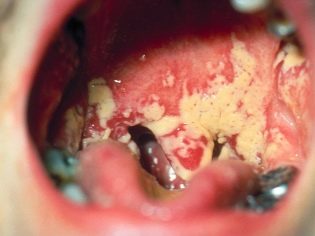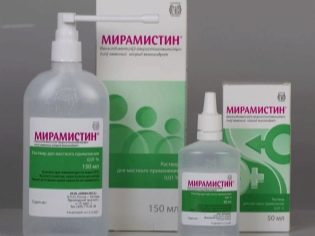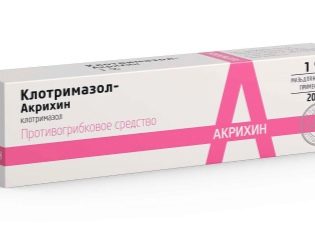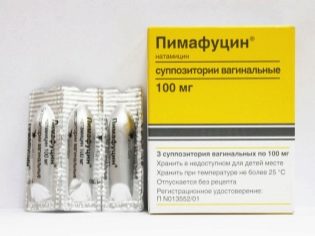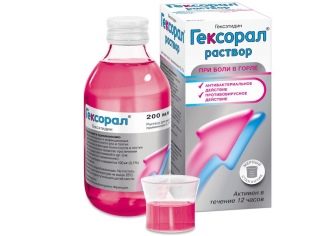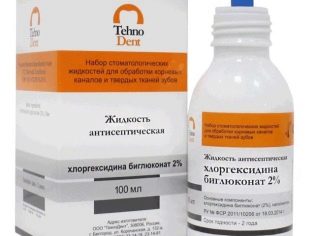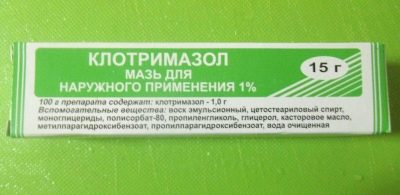Candidiasis in children
Emerging thrush causes many discomfort in the child. Frequent exacerbations of the disease suggest that there are signs of severe ill-being in the children's body, which he will signal as manifestations of candidiasis.
What it is?
Candidiasis is a disease caused by fungi. In everyday life, the name “thrush” stuck to them. This is due to the presence of specific symptoms that occur with candidiasis. The disease usually occurs in young children in different ways. In most cases, the course of the disease is mild. In newborns, candidiasis develops more severely and is accompanied by the appearance of numerous discomfort symptoms, which greatly worsen the baby’s well-being.
The culprit of the disease are special types of fungi - Candida. They may be present in small quantities and in a healthy child. When exposed to various provoking exogenous and endogenous factors, the number of candida in the body increases many times. Increased fungal colonies are able to settle on various mucous membranes. This causes numerous clinical variants of the disease with different localization.
The disease can occur in both girls and boys. According to statistics, cases of candidiasis are more often recorded in babies. This feature is due to the peculiarity of the structure and physiology of the female body. In early childhood, both boys and girls develop candidiasis equally often. To eliminate the adverse symptoms of the disease requires the appointment of special treatment.
The reasons
Currently, there are a huge number of provoking factors leading to enhanced growth and reproduction of fungal flora. Each age has its own leading causes contributing to the disease. Activation of the growth of fungi is possible in any physiological state, accompanied by a decrease in immunity.
The most common causes of the disease include:
- Infection during childbirth. In this case, the infection of the child occurs at the moment when he passes through the birth canal. If the mother is sick with candidiasis, the baby often has signs of this infection immediately after birth. In this situation, adverse symptoms of the disease can be found already in the baby.
- Direct contact with the mother. This form of the disease is usually found in the first days after the birth of the baby. If the mother has signs of an acute form of candidiasis, then she can infect the newborn baby with this disease. Premature babies are most susceptible to this type of infection.
- Non-compliance with personal hygiene. You can become infected with candidiasis by using someone else’s towels. There are also confirmed cases of the disease after bathing in the untreated disinfectant bath. The risk of infection in toddlers at the same time is higher than in older children.
- Prematurity In premature babies, immune system performance is often reduced. Any infection, including a fungal infection, easily causes infection and the appearance of adverse symptoms in them.
- Habnormalities or clinical conditions occurring in violation of carbohydrate metabolism. Diabetes mellitus type II or alimentary obesity contributes to the development of thrush in babies.Glycemia or elevated blood glucose provokes active growth and rapid reproduction of fungal flora. Chronic metabolic disorders often contribute to the development of children's candidiasis.
- Too long taking a number of drugs. These include: antibacterial agents, cytostatics and steroid hormones. With their long reception disrupted the immune system. Subsequently, this leads to the development in the child of signs of immunodeficiency states that contribute to the appearance of thrush.
- Frequent respiratory infections. Weakened babies have lower immunity. After severe and frequent colds, the child's body dramatically weakens. In such children, as a rule, the growth of fungal flora increases, which leads to the appearance of signs of candidiasis.
- Immunodeficiency states. Can be congenital and acquired as a result of various diseases. Not enough effective work of the immune system often contributes to the rapid growth of various opportunistic microorganisms, including Candida fungi. A prolonged decrease in immunity leads to the appearance in the child of adverse symptoms of thrush.
- Chronic diseases of internal organs. Pathologies of the gastrointestinal organs often contribute to the appearance of a fungal infection in the body. Impaired digestion provokes the rapid development of fungi in children. If the treatment of chronic diseases of the gastrointestinal tract is not carried out fully or is chosen incorrectly, then this can cause the appearance of resistant thrush.
Kinds
Doctors distinguish several variants of the disease by localization:
- In the oral cavity. Settling in the mouth, fungi cause various numerous damages. These include: cheilitis, stomatitis, gingivitis, says. According to statistics, oral candidiasis is most common in infants and schoolchildren. Newborn babies can become infected from the mother during breastfeeding.
- In the throat. A rather rare form of candidiasis. Often this clinical type of thrush is masked by various childhood infections. To establish the correct diagnosis in this case requires a differential diagnosis. This type of candidiasis usually violates breathing and can occur in a rather severe form.
- On the face and in the eye area. This type of candidiasis occurs with the appearance of lacrimation, severe swelling of the eyelids. In some cases, a white, turbid discharge, which contains a large number of fungi, flows out of the eyes. This form of candidiasis is dangerous because of the appearance of complications - various visual impairments.
- In the intestines. A provoking cause in this case often becomes dysbacteriosis or chronic diseases of the gastrointestinal tract. Long-term constipation contributes to the formation in the baby also anal forms of candidiasis. The treatment of such forms of thrush is a pediatric gastroenterologist.
- In the esophagus. It causes dyspepsia and provokes the appearance of heartburn. To identify the esophagus candidiasis, fibrogastroscopy with the collection of biological material for research is necessary. This differential diagnosis is carried out in order to exclude various neoplasms in the esophagus.
- In the brain. A rather rare clinical form, however, is very dangerous. The course of the disease is extremely difficult. Symptoms of the disease resembles meningitis. To eliminate the adverse symptoms, including severe headache and persistent nausea, use large doses of antifungal drugs.
- Vaginal. It is the most common form. Localization - in the groin. In girls with this form of candidiasis appear cheesy vaginal discharge. Many acute forms of thrush can become chronic.
- In the respiratory system. The fungal flora contributes to the development of candidal bronchitis.This disease causes coughing and breathing problems in a child. Cough is most often dry, but sputum may appear when attaching the bacterial flora. In some cases, hoarseness or hoarseness of voice appears, as well as body temperature rises and intoxication increases.
- On hands. Most often, candidal infection affects the nails. They become brittle and dull, and also quite easily broken and crumbled. Numerous white transverse grooves appear on the upper surface of the nails.
Candida fungi like to settle on various mucous membranes, less often - on the skin. Such a selective feature is caused by the feature of their anatomical and physiological structure. It also causes a variety of different clinical variants of the disease.
Symptoms
Thrush occurs with numerous clinical manifestations. They are rather difficult to carry and bring strong discomfort to the baby. The severity of symptoms may be different and depends on the initial state of the child before the disease.
The presence of a large number of chronic diseases or pronounced immunodeficiency in a baby markedly worsens the course of the disease and contributes to its transition to the chronic form.
The most common symptoms include:
- The appearance of white cheesy plaque. It may in small quantities or substantially cover damaged areas. When you touch it on the fly - it starts to crumble and break. When trying to remove it on the mucous membranes are eroded areas that can bleed. The color of the bloom is often white or with a grayish tint.
- Puffiness. Multiplying, fungi cause severe inflammation. The inflammatory process provokes the appearance of tissue edema. Inflamed mucous membranes become dense, bright red. Swelling of the tongue leads to pain when swallowing, and also helps reduce appetite.
- Impaired sucking. Oral forms of candidiasis cause feeding problems in infants. They are hardly able to suck mother's milk. During feeding the baby becomes capricious, crying. Severe soreness in the oral cavity, as well as burning, lead to the fact that the baby is less and less applied to the mother's breast.
- Cracks in the corners of the mouth. Occur with candidal heylitis. This symptom can be seen at home. In the outer corners of the mouth, the child appears deep grooves. During the meal, they can be injured and bleed.
- Tearing and eyelid soreness. This symptom is characteristic of candidal conjunctivitis. Usually the process is two-way. The duration of the disease in this case varies. On average, it is about 2-3 weeks.
- Itching and burning in the genitals. Occur with candidiasis of the intimate zone. They bring strong discomfort to the child and make him feel worse.
- Frequent urination. It is found in vaginal candidiasis, as well as in the defeat of the fungal infection of the urinary tract. The portions of urine do not change, as well as the total number per day. Only the multiplicity and number of the urge to urinate increases.
- Nausea and vomiting. Occur with candidiasis of the gastrointestinal organs. Establishing a diagnosis in this case is a very difficult task. Nausea can be permanent and difficult to eliminate with conventional medicines.
- Changes in the skin and nails. In appearance it may resemble dermatitis. In babies of early age, usually appears first in the area of skin folds. In appearance, it may resemble small swollen bumps with muddy contents inside.
- Violation of general well-being. Severe forms of candidiasis are accompanied by fever and an increase in toxic symptoms. Quite hard thrush occurs in babies of the first year of life. The severity of the condition affects the behavior of the child.It becomes more lethargic and capricious, increases daytime sleepiness and some passivity, increases nervousness.
Diagnostics
Suspect the first signs of candidiasis can any mother. They are usually quite pronounced and are very specific. However, when clinical candidal signs are detected, it is necessary to show the baby to the doctor. The doctor will conduct a clinical examination, and in some cases also additional studies for differential diagnosis.
This is necessary in order to exclude all diseases under which candidiasis can mask.
Usually with candidal infections prescribe:
- General blood analysis. Gives a descriptive picture of the presence of infection in the children's body. It also helps to establish the severity of functional disorders. This method is indicative and not the basis of diagnosis.
- PCR. This method allows you to accurately detect the presence of fungus in various biological material. To conduct this test will require a preliminary collection of plaque.
- Microscopy Using a high-resolution microscope, you can detect the fungus in any environment. In some cases, for a more accurate result, doctors use pre-staining material. This helps to identify the fungus even in difficult diagnostic cases.
- Serology. With the help of CSC and agglutination reaction, fungi can be detected in the urine, blood separated from the eyes, plaque from the vagina and other secrets. In some cases, this method is used to detect visceral forms of candidiasis or after a spinal puncture.
Treatment
Treat candidal infection as soon as possible, immediately after diagnosis. Late therapy may contribute to the progression of the disease and its transition to the chronic form. For the treatment of used various drugs that have a detrimental effect on the fungus, as well as improving immunity. To eliminate the symptoms of candidal infections in babies, various antifungal drugs are used. They can be systemic and local actions.
The choice of means, its dosage and the multiplicity of treatment is chosen by the attending physician based on the initial severity of the child’s condition and the presence of concomitant diseases of the internal organs.
Local treatment is carried out with various ointments that have a detrimental effect on candidate fungi. These include: clotrimazole, pimafucin (natamycin), isoconazole (herbal agent), ketoconazole, triderm (effective for the treatment of candidiasis of the feet) and others. It usually takes about two weeks to eliminate the adverse symptoms of the disease. Longer use of medicinal ointments is discussed with your doctor. If the disease proceeds in a more protracted form, then the prescription of antifungal drugs with systemic action is already required. To enhance the therapeutic effect, fluconazole is added to topical therapy.
It can be in various forms of release: suspensions and capsules, as well as tablets. Usually a dose of 6-8 mg / kg is used per day. The duration of treatment is determined depending on the severity of the disease.
Common forms of skin candidiasis are treated with the appointment of fluconazole at a dosage of 8-10 mg / kg per day. Usually, the entire dose of the drug is taken once a day. The treatment of skin candidiasis also includes the prescription of local forms of antifungal drugs. The average duration of treatment is usually 14-21 days.
For the treatment of mucous membranes of the oral cavity that are inflamed and damaged by candida infection Hexoral or 2% sodium digluconate solution. Treat plots should be 3-4 times a day. If the process is mild, then such local treatment is quite enough. With the recurrence of the disease is required the appointment of fluconazole (diflucan, mycosyst, medoflucon) inside.
In a hospital setting, newborn babies can use treatment regimens that include therapeutic dosages of nystatin.
For candidiasis of the genital organs, you can use antifungal ointments. For this fit 1% clotrimazole and 1% herbal. The duration of prescribing depends on the severity of the disease and the severity of clinical symptoms. With the ineffectiveness of local treatment, as well as the deterioration of the condition requires the appointment of systemic antifungal agents. Visceral candidiasis is a difficult task to treat. Usually, to eliminate adverse symptoms require the appointment of complex therapy. In case of candidiasis of the gastrointestinal organs, treatment regimens are used, including the combined administration of fluconazole and nystatin simultaneously. Fluconazole appointed in the dosage of 9-10 mg / kg of body weight, and nystatin 70 000- 100 000 U / day up to 3-4 times a day.
The duration of the use of drugs depends on the clinical form of candidiasis, as well as its localization. On average, 1.5-2 weeks is enough to eliminate the adverse symptoms. However, in some cases a longer medication is required. Treatment must be chosen correctly in order to prevent possible relapses of the disease as much as possible in the future. During the course of therapy, the effectiveness of the prescribed treatment is monitored. Also, doctors can prescribe a baby general blood tests. These tests are necessary to establish adverse side reactions on the part of the child's body with prolonged use of antifungal drugs.
At the end of the course of treatment carried out, a full laboratory control is carried out with the determination of the residual presence of fungi.
In the treatment of fungal infections, great attention should be paid to the nutrition of the baby. For the entire acute period of the disease, the child is assigned a special diet. It completely eliminates any sweet foods, as it promotes the growth of fungal flora. Also, all pickled and canned dishes, spicy or spicy foods are removed from the diet. Meals should be fractional, at least 4-5 times a day.
For cooking, it is better to use a slow cooker or a double boiler, stewing and steaming is allowed.
Prevention
Preventive measures play an important role in preventing candidiasis in babies. Regular adherence to simple rules will help keep the child's body healthy and will protect from thrush. It is important to remember that they should be observed every day. Any violation can lead to the appearance of adverse symptoms of candidiasis.
In order not to get thrush, you should:
- Strengthen immunity. This is facilitated by proper nutrition, healthy sleep, as well as optimally chosen physical activity. Strong stress significantly weakens the immune system. Excessive psycho-emotional stress is better to exclude. Regular hardening also improves immunity.
- Favorable indoor climate. Many doctors believe that excessive dryness in the children's room, as well as the wrong temperature, can lead to the development of candidiasis. To maintain the good health of the child, try to monitor the humidity in the room. This will help the special devices that moisturize the air.
- Take a walk in the fresh air. It has been scientifically proven that oxygen has a detrimental effect on various microorganisms. Regular walks on the street will help the immune system work better and improve the baby’s stamina.
- Follow the rules of personal hygiene. Washing your hands regularly, treating your nipples before and after breastfeeding, using personal towels and bath sponges are simple ways to prevent contact candidiasis. Follow the rules of personal hygiene should be all family members.Babies should be taught this from the earliest years of life.
How to treat oral candidiasis in children, see the next video.
